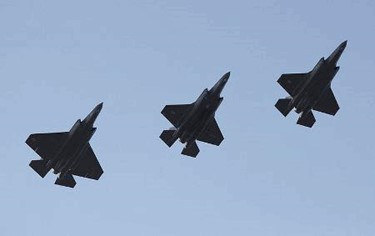U.S. Air Force Aims To Deploy Laser-Armed Fighter Jets By 2021
By Jof Enriquez,
Follow me on Twitter @jofenriq

The United States Air Force Research Laboratory (AFRL), through its Self-protect High Energy Laser Demonstrator (SHiELD) program, has awarded Lockheed Martin a $26.3 million contract to design, develop and produce a high-power fiber laser mounted on a tactical fighter jet by 2021.
In March, Lockheed Martin successfully tested for the U.S. Army a world-record 60 kW-class beam combined fiber laser, which brings together individual lasers from fiber optics to generate a single, intense laser beam. It is based on ATHENA, a ground-based, truck-mounted laser system. The U.S. Air Force wanted to take another step forward with these types of lasers by having contractors develop them into protective airborne laser systems.
Lockheed Martin already has committed to building a heavier airborne version – a 5,000-pound, 200-kilowatt offensive laser cannon to be mounted on AC-130 gunships, according to Yahoo. Now, the defense contractor wants to reduce the size and weight of its high-energy laser system for mounting aboard the Air Force's fighter jets. In particular, a compact version could take advantage of the F-35's powerful engines, which are capable of producing 20 megawatts of power.
"Earlier this year, we delivered a 60 kW-class laser to be installed on a U.S. Army ground vehicle. It's a completely new and different challenge to get a laser system into a smaller, airborne test platform. It's exciting to see this technology mature enough to embed in an aircraft," said Dr. Rob Afzal, senior fellow of laser weapon systems at Lockheed Martin. "The development of high-power laser systems like SHiELD shows laser weapon system technologies are becoming real. The technologies are ready to be produced, tested, and deployed on aircraft, ground vehicles, and ships."
In October, Lockheed Martin was awarded a separate contract to combine advanced beam control systems and a fiber laser on a high-performance, high-altitude platform to intercept missiles.
For AFRL’s SHiELD program, the high-energy laser to be developed by Lockheed Martin represents the Laser Advancements for Next-generation Compact Environments (LANCE) component. Another subsystem, the SHiELD Turret Research in Aero Effects (STRAFE), is the beam control system used for targeting. Northrop Grumman will develop STRAFE. Boeing is developing the third component, the Laser Pod Research & Development (LPRD), which is the housing that will power and cool the laser.
“Not only have we reduced size, weight, and power enough to move from a large plane to a tactical fighter jet, we’ve also reduced the laser to be part of a pod,” Afzal told Wired. “This is a technology maturity level that just five years ago we would have said may take a long time to develop.”
A turning point for laser weapon technology was the shift away from the chemical laser, which requires large amounts of chemicals to generate the reaction that produces its powerful beam, in favor of more efficient solid-state lasers, which run on electricity.
